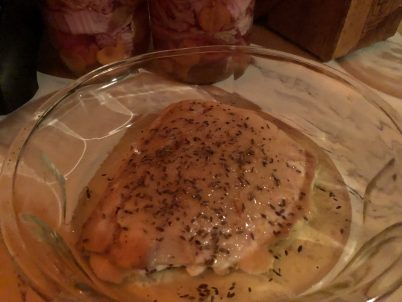
photo credit: Bobbi Misiti
Ingredients
- Salmon filet (wild caught)
- Coconut oil or butter
- Salt and pepper
- Herbs of your choice depending on cooking method, etc.
- Juice of half lemon, optional
Instructions
There are 4 ways to cook salmon below. Choose your method (pan-frying on the stove, oven, grill or poach) and gather your ingredients accordingly.
How to cook Salmon on the Stove: Pan-Frying Salmon
Pan-frying is great for salmon fillets, mainly because it’s easy and quick. Another bonus is that frying gives the skin a crunchy and crispy texture (some even compare it to bacon). Just remember that when frying salmon (or any food), it’s best to use coconut oil instead of other cooking oils.
The fillet should be room temperature, not cold. According to The Kitchn:
“When cold fish is added to a hot pan, the fillets will immediately seize up and are more likely to cook unevenly. Instead, remove the fish from the refrigerator about 15 to 20 minutes before you’re ready to start cooking, in order to bring them up to room temperature.”
Dry the fillets properly before frying. Pat the salmon fillets dry with a clean dish towel or a paper towel. This will prevent them from sticking to the pan and will also give the skin a nice crisp. Sprinkle with salt and pepper before putting the fish in the pan.
Make sure the pan is really hot before adding anything in. The flame should be medium or medium-high. Pour in a thin layer of coconut oil and let it heat up until the oil is shimmering. To check if the oil is hot enough, flick a few drops of water into the pan — if they sizzle and evaporate at once, it’s good to go.
Put the salmon on the pan skin side down. Salmon skin is durable and tough, and is able to withstand more time on the hot skillet without overcooking. Don’t forget to season the fillets before adding it in the pan. Add them one by one as well, careful as you do so, to avoid being splattered by oil.
Don’t be tempted to move around the salmon. Do not prod or poke it with a spatula or it might break apart. Instead, let it sizzle for five to six minutes before flipping it to cook the other side.
Remember that when pan-frying salmon, the large portion of the cooking process happens when the skin is resting against the pan’s surface. Keep a close eye on the fish without touching it — you’ll see the fillet’s color beginning to change, lightening from deep dark red to pale pink.
Once the color has changed to three-quarters from the bottom, you can flip the salmon. Let it cook for a couple more minutes — you’ll get a tender and flaky fish with a super-crispy skin.
How to Cook Salmon in the Oven
Baking salmon in the oven is one of the easiest and fuss-free ways to cook this fish. The cleanup is also minimal, as long as you remember to line your baking tray. Follow these easy steps from Greatist:
Preheat oven to 400 degrees Fahrenheit. Line your baking dish or sheet tray with parchment paper and place the salmon fillets on top. Pat them dry with a paper towel.
Drizzle coconut oil all over the salmon and sprinkle with salt and pepper to taste (you can use any other seasonings or herbs you prefer — Dill is excellent on salmon :).
Place in the top half of the oven and allow to bake for 8 to 12 minutes. Around the 8-minute mark, you can start checking for doneness, but remember that if the fillet is thicker, it will need more time. When the flesh flakes easily with a fork, it’s ready to be served.
Optional: Squeeze a wedge of lemon all over the salmon before serving for an added citrusy flavor.
How to Grill Salmon
A summertime favorite for many people is grilled salmon steak or fillet, and for good reason — grilling not only imparts a smoky flavor to the fish, but less cleanup is needed as well. Keep in mind these tips:
Make sure you start with hot coals, placing the lightly oiled fish skin-sides down on the grate diagonally, giving them the lovely grill marks.
Flip it after five minutes. To do this, simply slide a spatula under the fish — if the flesh refuses to separate from the grate, leave it for another minute or two and then try again.
Make sure that you do not char the meat while cooking.
How to Poach Salmon
If you don’t like your salmon to be too oily because of using coconut oil, poaching is a great alternative you can try. It’s also great if you want to “sauce up” your salmon or are planning to transform it into fresh salmon fish cakes.
To poach salmon, simply simmer the fish in water flavored with a pinch of salt, a few whole peppercorns, or a bay leaf. Make sure there’s enough water (you can also use homemade bone broth for a deeper flavor) covering the fillets. For a gentle poach, let the water or other liquid simmer, slide the fish in and cover the pan. Turn off the heat and allow the salmon to gently cook for 20-25 minutes.
Notes:
How will you know if salmon is done cooking?
According to the U.S. Food and Drug Administration, most seafood, including fish like salmon, should be cooked to an internal temperature of 145 degrees Fahrenheit. You can use a meat thermometer to check the doneness of your salmon. Push the tip into the middle of the fillet, at the thickest part. Ideally, check the internal temperature of the salmon a few minutes before it’s finished cooking, so that you will avoid overcooking the fish. Look for salmon that is opaque — the meat should slightly resist flaking or pulling away from the bone.
Pressing the top of the fish also lets you check if the salmon is cooked. The fish should be firm to the touch, but will give a bit when pressure is applied to it. Signs that the salmon is overcooked is opaque meat that easily flakes or breaks apart — this means there’s a lack of moisture in it.
*****
Wild for Salmon is where I get all my salmon. Its a PA family that has a boat in Alaska at Bristol Bay. They spend their summers there fishing. You can buy from their website and they ship in dry ice or you can order through a co-op. We have a co-op, they usually do deliveries twice a year at a house in Lemoyne. The buying club is Wertz’s Wild4Salmon Buying club.
*****
Notes are from Mercola.com and others where noted.
